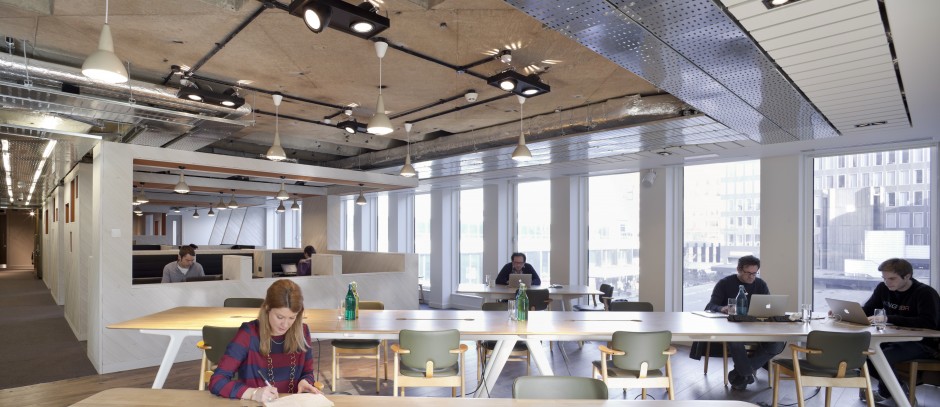The Office Group is a design-led workspace provider that houses a diverse community of businesses and individuals. Today, they have over 20 established buildings across central London, Bristol and Leeds. Members can decide whether they want to work from a private office, virtual addresses or collaborative coworking space.
We spoke with founder Oliver Olsen, about connectivity, convenience and how space managers can create a healthy, vibrant lifestyle for their members.
How did you imagine an open office when you started TOG, and how do you see the social workplace as representative of a new model of work?
The Office Group Co-CEO Charlie Green and I we were spurred to set up in business based on the desire to get out of the corporate world and create offices that were markedly different to the industry standard.
In all of our various workspaces, we strive to create a sense of community and collaboration. This is important as businesses are becoming more fluid in the way they operate. For example, the use of freelancers and temporary staff joining for short-term projects tends to be more agile and with flexible working hours, remote working, and the rise of the sharing economy there is a growing need to find expertise and advice quickly.
An effective workspace should make it easier for members to find out about each other and thus connect. The person you might need on your next project could be sitting in the same room as you.
Please describe the design of your space. Why are aesthetics and atmosphere so important in today’s workspace?
One of the main reasons we wanted to create our own workspaces was that we couldn’t see any offices out there that we would want to work in ourselves.
Our spaces are designed to be comfortable, vibrant, light, and all styles of work. We display artwork from local artists and create bespoke art pieces for each building that reference the history of the building or area.
The look and feel of an office space is important simply because employees spend so much of their day at work. The environment has such a big impact on individual well-being, productivity and creativity that you have to have this in mind at every stage of the design process.
How did you realize what type of space design nurtured productivity?
We learned from our own backgrounds in the industry, and we took as much from the bad things as we did from the good. We work with top architects, interior designers, furniture suppliers and a skilled in-house property team who receive feedback from our members and building managers when it comes to considering the design of a new space.
In your opinion, how has the development of these open spaces influenced the culture of work?
Open coworking spaces have proved that work doesn’t have to mean a traditional 9 to 5 office-based role. They have in turn show that a social, open workspace makes any type of work possible. Many of our members work in teams that are spread throughout the globe, but they are able to work seamlessly through conference calling, Skype and Slack.
Who usually joins the Office Group and what services do you offer them?
Our Community includes everyone from solo freelancers to multi-national blue-chip companies and every type of business in-between. We’re particularly popular with start-up tech companies, creative agencies, recruiters and design firms.
What are the challenges of creating a productive workplace for freelancers?
Today, high-speed wireless internet has allowed start-ups and smaller businesses to be more agile than ever and also allows then to work from anywhere. Therefore, our biggest challenge is to provide an environment that offers real value over and above free workspaces or working from home. We believe that the key to this value is people.
Despite the many ways for business people to connect with each other digitally, what we see is a real desire for real human interaction amongst our members. Our Community Managers get to know all of our members, and help with anything they might need and connect them to others that they might be able to work with.
It seems that larger companies are steadily gravitating towards social workplaces, why do you think that is?
Companies are beginning to realize the importance of social interaction with organizations, both from an employee happiness perspective and from one of innovation. They understand that new ideas can be sparked by the ‘water cooler’ moments and cross-department chats.
Many companies are actively designing their offices in a way that encourages employees to meet, chat and create the ‘eureka’ moments. Today, rather than packing the most offices possible into a building, we’re seeing an emerging trend focused on leisure spaces and open workspaces.
How are the expectations of the modern workforce different from previous models? How does the Office Group address these modern needs?
The view of what an office should be has changed dramatically in the last 5 years. People no longer look for 4 walls and a door, rather they want a space that is light and flexible to suit the changing needs of their business. Most people want a space that looks good, feels good and helps their team be productive.
In addition to this, the way we work is changing. Digital technologies are disrupting almost every industry as well as creating entirely new ones overnight. We need to ensure that our spaces meet the needs of these new ‘digital employees’ and caters equally to those who demand flexible space, like a meeting room for an hour, a desk for just a few days a week, or even just a business address or phone number.




0 Comments